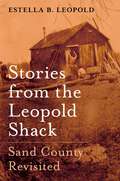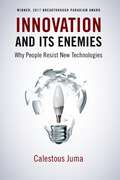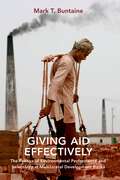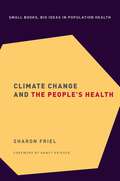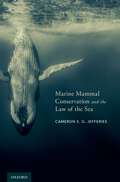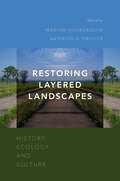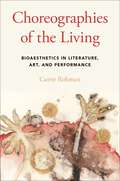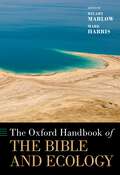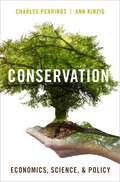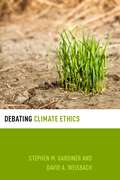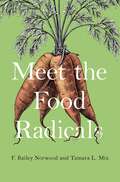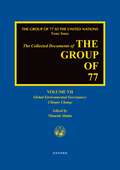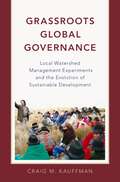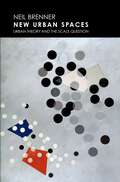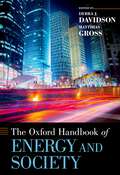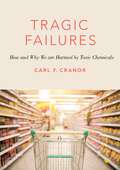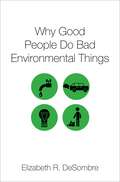- Table View
- List View
Stories from the Leopold Shack: Sand County Revisited
by Estella B. LeopoldIn 1934, conservationist Aldo Leopold and his wife Estella bought a barn - the remnant of a farm - and surrounding lands in south-central Wisconsin. The entire Leopold clan - five children in all - worked together to put into practice Aldo's "land ethic," which involved ecological restoration and sustainability. In the process, they built more than a pleasant weekend getaway; they established a new way of relating to nature. In 1948, A Sand County Almanac was published, and it has become a beloved and foundational text of the conservation movement. Decades later, Estella B. Leopold, the youngest of the Leopold children - she was eight when they bought the land - now reflects on the "Shack," as they called the repurposed barn, and its inhabitants, and recalls with clear-eyed fondness the part it played in her and her siblings' burgeoning awareness of nature's miracles, season by season. In Stories from the Leopold Shack: Sand County Revisited, she unforgettably recalls the intensity of those days: the taste of fresh honey on sourdough pancakes; the trumpeting arrival of migrating Canada geese; the awesome power of river ice driven by currents - and each description is accompanied by stunning photographs by her brother, A. Carl Leopold. As the Leopolds worked to restore degraded farmland back to its original prairie and woods, they noted and celebrated all of the flora and fauna that came to share the Shack lands. As first evoked in A Sand County Almanac, and now revisited in Stories from the Leopold Shack, the Leopold family's efforts of ecological restoration were among the earliest in the United States, and their work, collectively and individually, continues to have a profound impact on land management and conservationism. All of Aldo and Estella Leopold's children went on to become distinguished scientists and to devote themselves to a life of conservation; their work continues through the Aldo Leopold Foundation. Estella B. Leopold book offers a voyage back to the place where it all began.
Innovation and Its Enemies: Why People Resist New Technologies
by Calestous JumaIt is a curious situation that technologies we now take for granted have, when first introduced, so often stoked public controversy and concern for public welfare. At the root of this tension is the perception that the benefits of new technologies will accrue only to small sections of society, while the risks will be more widely distributed. Drawing from nearly 600 years of technology history, Calestous Juma identifies the tension between the need for innovation and the pressure to maintain continuity, social order, and stability as one of today's biggest policy challenges. He reveals the extent to which modern technological controversies grow out of distrust in public and private institutions and shows how new technologies emerge, take root, and create new institutional ecologies that favor their establishment in the marketplace. Innovation and Its Enemies calls upon public leaders to work with scientists, engineers, and entrepreneurs to manage technological change and expand public engagement on scientific and technological matters.
Innovation and Its Enemies: Why People Resist New Technologies
by Calestous JumaIt is a curious situation that technologies we now take for granted have, when first introduced, so often stoked public controversy and concern for public welfare. At the root of this tension is the perception that the benefits of new technologies will accrue only to small sections of society, while the risks will be more widely distributed. Drawing from nearly 600 years of technology history, Calestous Juma identifies the tension between the need for innovation and the pressure to maintain continuity, social order, and stability as one of today's biggest policy challenges. He reveals the extent to which modern technological controversies grow out of distrust in public and private institutions and shows how new technologies emerge, take root, and create new institutional ecologies that favor their establishment in the marketplace. Innovation and Its Enemies calls upon public leaders to work with scientists, engineers, and entrepreneurs to manage technological change and expand public engagement on scientific and technological matters.
Giving Aid Effectively: The Politics of Environmental Performance and Selectivity at Multilateral Development Banks
by Mark T. BuntaineInternational organizations do not always live up to the expectations and mandates of their member countries. One of the best examples of this gap is the environmental performance of multilateral development banks, which are tasked with allocating and managing approximately half of all development assistance worldwide. In the 1980s and 1990s, the multilateral development banks came under severe criticism for financing projects that caused extensive deforestation, polluted large urban areas, displaced millions of people, and destroyed valuable natural resources. In response to significant and public failures, member countries established or strengthened administrative procedures, citizen complaint mechanisms, project evaluation, and strategic planning processes. All of these reforms intended to close the gap between the mandates and performance of the multilateral development banks by shaping the way projects are approved. Giving Aid Effectively provides a systematic examination of whether these efforts have succeeded in aligning allocation decisions with performance. Mark T. Buntaine argues that the most important way to give aid effectively is selectivity - moving towards projects with a record of success and away from projects with a record of failure for individual recipient countries. This book shows that under certain circumstances, the control mechanisms established to close the gap between mandate and performance have achieved selectivity. Member countries prompt the multilateral development banks to give aid more effectively when they generate information about the outcomes of past operations and use that information to make less successful projects harder to approve or more successful projects easier to approve. This argument is substantiated with the most extensive analysis of evaluations across four multilateral development banks ever completed, together with in-depth case studies and dozens of interviews. More generally, Giving Aid Effectively demonstrates that member countries have a number of mechanisms that allow them to manage international organizations for results.
Climate Change and the People's Health (Small Books Big Ideas in Population Heal)
by Sharon FrielClimate change and social inequity are both sprawling, insidious forces that threaten populations around the world. It's time we start talking about them together. Climate Change and the People's Health offers a brave and ambitious new framework for understanding how our planet's two greatest existential threats comingle, complement, and amplify one another -- and what can be done to mitigate future harm. In doing so it posits three new modes of thinking: · That climate change interacts with the social determinants of health and exacerbates existing health inequities · The idea of a "consumptagenic system" -- a network of policies, processes, governance and modes of understanding that fuel unhealthy, and environmentally destructive production and consumption · The steps necessary to move from denial and inertia toward effective mobilization, including economic, social, and policy interventions With insights from physical science, social science, and humanities, this short book examines how climate change and social inequity are indelibly linked, and considering them together can bring about effective change in social equity, health, and the environment.
Climate Change and the People's Health (Small Books Big Ideas in Population Heal)
by Sharon FrielClimate change and social inequity are both sprawling, insidious forces that threaten populations around the world. It's time we start talking about them together. Climate Change and the People's Health offers a brave and ambitious new framework for understanding how our planet's two greatest existential threats comingle, complement, and amplify one another -- and what can be done to mitigate future harm. In doing so it posits three new modes of thinking: · That climate change interacts with the social determinants of health and exacerbates existing health inequities · The idea of a "consumptagenic system" -- a network of policies, processes, governance and modes of understanding that fuel unhealthy, and environmentally destructive production and consumption · The steps necessary to move from denial and inertia toward effective mobilization, including economic, social, and policy interventions With insights from physical science, social science, and humanities, this short book examines how climate change and social inequity are indelibly linked, and considering them together can bring about effective change in social equity, health, and the environment.
Marine Mammal Conservation and the Law of the Sea
by Cameron S. JefferiesMarine mammal conservation remains a hot-button international environmental issue, but progress towards addressing key conservation and management issues within existing governance structures-most notably the International Whaling Commission-has stalled. Cameron Jefferies offers a fresh look at the future of international marine mammal management in a way that advances the ongoing dialog surrounding UNCLOS implementation and effective living marine resource management, while employing the comprehensive rational decision-making model as a theoretical framework. Marine Mammal Conservation and the Law of the Sea lays out and critiques the marine mammal regulatory landscape. It introduces the rational conservation model, and details the modern threats to marine mammals, including climate change, by-catch, environmental pollution, ship strikes. Next, it discusses options for reform under UNCLOS and existing treaties, and finally introduces a new holistic treaty regime based on the rational conversation model, based in part on the UN Fish Stocks Agreement. This book will appeal to scholars, practitioners, and policymakers across public international law, international relations, political science, and environmental policy in the academic, governmental, IO, and NGO spheres.
Marine Mammal Conservation and the Law of the Sea
by Cameron S. JefferiesMarine mammal conservation remains a hot-button international environmental issue, but progress towards addressing key conservation and management issues within existing governance structures-most notably the International Whaling Commission-has stalled. Cameron Jefferies offers a fresh look at the future of international marine mammal management in a way that advances the ongoing dialog surrounding UNCLOS implementation and effective living marine resource management, while employing the comprehensive rational decision-making model as a theoretical framework. Marine Mammal Conservation and the Law of the Sea lays out and critiques the marine mammal regulatory landscape. It introduces the rational conservation model, and details the modern threats to marine mammals, including climate change, by-catch, environmental pollution, ship strikes. Next, it discusses options for reform under UNCLOS and existing treaties, and finally introduces a new holistic treaty regime based on the rational conversation model, based in part on the UN Fish Stocks Agreement. This book will appeal to scholars, practitioners, and policymakers across public international law, international relations, political science, and environmental policy in the academic, governmental, IO, and NGO spheres.
RESTORING LAYERED LANDSCAPES C: History, Ecology, and Culture
by Marion Hourdequin and David G. HavlickRestoring Layered Landscapes brings together historians, geographers, philosophers, and interdisciplinary scholars to explore ecological restoration in landscapes with complex histories shaped by ongoing interactions between humans and nature. For many decades, ecological restoration - particularly in the United States - focused on returning degraded sites to conditions that prevailed prior to human influence. This model has been broadened in recent decades, and restoration now increasingly focuses on the recovery of ecological functions and processes rather than on returning a site to a specific historical state. Nevertheless, neither the theory nor the practice of restoration has fully come to terms with the challenges of restoring layered landscapes, where nature and culture shape one another in deep and ongoing relationships. Former military and industrial sites provide paradigmatic examples of layered landscapes. Many of these sites are not only characterized by natural ecosystems worth preserving and restoring, but also embody significant political, social, and cultural histories. This volume grapples with the challenges of restoring and interpreting such complex sites: What should we aim to restore in such places? How can restoration adequately take the legacies of human use into account? Should traces of the past be left on the landscape, and how can interpretive strategies be creatively employed to make visible the complex legacies of an open pit mine or chemical weapons manufacturing plant? Restoration aims to create new value, but not always without loss. Restoration often disrupts existing ecosystems, infrastructure, and artifacts. The chapters in this volume consider what restoration can tell us more generally about the relationship between continuity and change, and how the past can and should inform our thinking about the future. These insights, in turn, will help foster a more thoughtful approach to human-environment relations in an era of unprecedented anthropogenic global environmental change.
Choreographies of the Living: Bioaesthetics in Literature, Art, and Performance
by Carrie RohmanChoreographies of the Living explores the implications of shifting from viewing art as an exclusively human undertaking to recognizing it as an activity that all living creatures enact. Carrie Rohman reveals the aesthetic impulse itself to be profoundly trans-species, and in doing so she revises our received wisdom about the value and functions of artistic capacities. Countering the long history of aesthetic theory in the West--beginning with Plato and Aristotle, and moving up through the recent claims of "neuroaesthetics"--Rohman challenges the likening of aesthetic experience to an exclusively human form of judgment. Turning toward the animal in new frameworks for understanding aesthetic impulses, Rohman emphasizes a deep coincidence of humans' and animals' elaborations of fundamental life forces. Examining a range of literary, visual, dance, and performance works and processes by modernist and contemporary figures such as Isadora Duncan, D. H. Lawrence, Virginia Woolf, and Merce Cunningham, Rohman reconceives the aesthetic itself not as a distinction separating humans from other animals, but rather as a framework connecting embodied beings. Her view challenges our species to acknowledge the shared status of art-making, one of our most hallowed and formerly exceptional activities.
The Oxford Handbook of the Bible and Ecology (Oxford Handbooks)
Environmental issues are an ever-increasing focus of public discourse and have proved concerning to religious groups as well as society more widely. Among biblical scholars, criticism of the Judeo-Christian tradition for its part in the worsening crisis has led to a small but growing field of study on ecology and the Bible. This volume in the Oxford Handbook series makes a significant contribution to this burgeoning interest in ecological hermeneutics, incorporating the best of international scholarship on ecology and the Bible. The Handbook comprises 30 individual essays on a wide range of relevant topics by established and emerging scholars. Arranged in four sections, the volume begins with a historical overview before tackling some key methodological issues. The second, substantial, section comprises thirteen essays offering detailed exegesis from an ecological perspective of selected biblical books. This is followed by a section exploring broader thematic topics such as the Imago Dei and stewardship. Finally, the volume concludes with a number of essays on contemporary perspectives and applications, including political and ethical considerations. The editors Hilary Marlow and Mark Harris have drawn on their experience in Hebrew Bible and New Testament respectively to bring together a diverse and engaging collection of essays on a subject of immense relevance. Its accessible style, comprehensive scope, and range of material means that the volume is a valuable resource, not only to students and scholars of the Bible but also to religious leaders and practitioners.
Conservation: Economics, Science, and Policy
by Charles Perrings Ann KinzigA unified theory of conservation that addresses the broad problem of conservation, the principles that inform conservation choices, and the application of those principles to the management of the natural world. The conservation of natural resources, like that of any other asset, involves trade-offs. Yet, in a world faced with the harsh realities of climate change, crafting the right environmental policies is an increasingly urgent task. In Conservation, Charles Perrings and Ann Kinzig bring together new research in economics and biodiversity to investigate conservation decisions and the theory behind them. Perrings and Kinzig apply the concept of conservation broadly to examine how the principles of conservation apply to the management of the natural world. They demonstrate that the same basic principles serve as the foundation of all rational conservation decisions, from managing financial assets to safeguarding at-risk ecosystems. Whether someone is deciding to hold or dispose of a stock or whether to exploit or preserve a natural resource, they are better off choosing to conserve a resource when its value to them, if conserved, is greater than its value when converted. The book also considers the context of such conservation decisions. Just as national tax rules influence choices about financial investments, environmental regulations within countries, and environmental agreements between countries, impact the decisions regarding natural resources. Building on their basic theory of conservation, Perrings and Kinzig address key issues in the field of environmental economics, including the valuation of ecosystem services and environmental assets; the limits on the substitutability of produced and natural capital; and the challenges posed by the often weak markets for ecosystem services oriented toward the public good. They also address the problem of scale: while decisions might be easier to make at the local level, many conservation policies need to apply at either the national or international level to succeed. Written by experts from both social and hard sciences, this book presents a unified theory of conservation and provides a model for a more effective way to approach the vitally important issue.
Conservation: Economics, Science, and Policy
by Ann Kinzig Charles PerringsA unified theory of conservation that addresses the broad problem of conservation, the principles that inform conservation choices, and the application of those principles to the management of the natural world. The conservation of natural resources, like that of any other asset, involves trade-offs. Yet, in a world faced with the harsh realities of climate change, crafting the right environmental policies is an increasingly urgent task. In Conservation, Charles Perrings and Ann Kinzig bring together new research in economics and biodiversity to investigate conservation decisions and the theory behind them. Perrings and Kinzig apply the concept of conservation broadly to examine how the principles of conservation apply to the management of the natural world. They demonstrate that the same basic principles serve as the foundation of all rational conservation decisions, from managing financial assets to safeguarding at-risk ecosystems. Whether someone is deciding to hold or dispose of a stock or whether to exploit or preserve a natural resource, they are better off choosing to conserve a resource when its value to them, if conserved, is greater than its value when converted. The book also considers the context of such conservation decisions. Just as national tax rules influence choices about financial investments, environmental regulations within countries, and environmental agreements between countries, impact the decisions regarding natural resources. Building on their basic theory of conservation, Perrings and Kinzig address key issues in the field of environmental economics, including the valuation of ecosystem services and environmental assets; the limits on the substitutability of produced and natural capital; and the challenges posed by the often weak markets for ecosystem services oriented toward the public good. They also address the problem of scale: while decisions might be easier to make at the local level, many conservation policies need to apply at either the national or international level to succeed. Written by experts from both social and hard sciences, this book presents a unified theory of conservation and provides a model for a more effective way to approach the vitally important issue.
Giving Aid Effectively
by Mark T. BuntaineIn Giving Aid Effectively, Mark T. Buntaine argues that countries that are members of international organizations have prompted multilateral development banks to give development and environmental aid more effectively by generating better information about performance. To reach this conclusion, he employs a systematic analysis of responses to evaluations and in-depth case studies about the use of information at multilateral development banks.
DEBATING CLIMATE ETHICS DEBETH C (Debating Ethics)
by Stephen M. Gardiner David A. WeisbachIn this volume, Stephen M. Gardiner and David A. Weisbach present arguments for and against the relevance of ethics to global climate policy. Gardiner argues that climate change is fundamentally an ethical issue, since it is an early instance of a distinctive challenge to ethical action (the perfect moral storm), and ethical concerns (such as with justice, rights, political legitimacy, community and humanity's relationship to nature) are at the heart of many of the decisions that need to be made. Consequently, climate policy that ignores ethics is at risk of "solving" the wrong problem, perhaps even to the extreme of endorsing forms of climate extortion. This is especially true of policy based on narrow forms of economic self-interest. By contrast, Weisbach argues that existing ethical theories are not well suited to addressing climate change. As applied to climate change, existing ethical theories suffer from internal logical problems and suggest infeasible strategies. Rather than following failed theories or waiting indefinitely for new and better ones, Weisbach argues that central motivation for climate policy is straightforward: it is in their common interest for people and nations to agree to policies that dramatically reduce emissions to prevent terrible harms.
Meet the Food Radicals
by F. Bailey Norwood Tamara L. MixThe food system has changed considerably in the last century. Horsepower was replaced by machine, better crop breeding programs helped usher in the Green Revolution, and problems of malnutrition began to run parallel with those of obesity. Despite changes, many of the problems we face remain the same. Farms continue to lose soil, and low income households still have difficulty acquiring healthy food. Add to these challenges a host of new ones. Globalization has caused some agricultural communities to feel threatened. Everyone recognizes problems of malnutrition, obesity and food sustainability, but many disagree on solutions. One thing is certain: confronting both familiar and new challenges will lead to radical changes in the food system. Though the exact form of radical change is unknown, this book looks to a host of candidates by interviewing the people who champion them. We are winning the battle against soil erosion through new no-till farming methods. Progress is being made in food sustainability by a spectrum of new innovations, but also a return to traditional farming techniques. New innovations include robots on the farm, advances in molecular biology, and alternative protein sources. As we embrace the farming strategies of our ancestors, we see farms returning to polycultures, local food systems, and food sovereignty. This book gains insight from interviews with twenty-seven individuals who are either creating or proposing radical changes in how food is produced and distributed. An eclectic group ranging from farmers to activists to spiritual gurus, they are the most interesting people you have never met. By getting to know each "radical" personally we can better access their voices and visions to understand both the problems and likely solutions to today's most pressing food problems.
Meet the Food Radicals
by F. Bailey Norwood Tamara L. MixThe food system has changed considerably in the last century. Horsepower was replaced by machine, better crop breeding programs helped usher in the Green Revolution, and problems of malnutrition began to run parallel with those of obesity. Despite changes, many of the problems we face remain the same. Farms continue to lose soil, and low income households still have difficulty acquiring healthy food. Add to these challenges a host of new ones. Globalization has caused some agricultural communities to feel threatened. Everyone recognizes problems of malnutrition, obesity and food sustainability, but many disagree on solutions. One thing is certain: confronting both familiar and new challenges will lead to radical changes in the food system. Though the exact form of radical change is unknown, this book looks to a host of candidates by interviewing the people who champion them. We are winning the battle against soil erosion through new no-till farming methods. Progress is being made in food sustainability by a spectrum of new innovations, but also a return to traditional farming techniques. New innovations include robots on the farm, advances in molecular biology, and alternative protein sources. As we embrace the farming strategies of our ancestors, we see farms returning to polycultures, local food systems, and food sovereignty. This book gains insight from interviews with twenty-seven individuals who are either creating or proposing radical changes in how food is produced and distributed. An eclectic group ranging from farmers to activists to spiritual gurus, they are the most interesting people you have never met. By getting to know each "radical" personally we can better access their voices and visions to understand both the problems and likely solutions to today's most pressing food problems.
The Collected Documents of the Group of 77, Volume VII: Global Environmental Governance: Climate Change
by Mourad AhmiaThis volume features a collection of documents pertaining to the Group of 77's commentary and efforts on global climate governance beginning in the early 1990s and continuing through 2018. It provides a record of the Global South's coordination and joint positions in the climate arena, and its participation in discussions and negotiations at the United Nations, including the UN Framework Convention on Climate Change. Like the previous volumes in the series, Volume VII of The Collected Documents of the Group of 77 at the United Nations offers a unique selection of materials, some of which are unavailable in any other format. Since its founding in 1964, the Group of 77 has worked to provide a voice for developing countries so as to give greater resonance to their shared aspirations. Over almost six decades, the Group of 77 has solidified the Global South as a coalition of nations, aspiring for a global partnership for peace and development. Documenting the Global South's contributions to the ever evolving efforts to combat climate change, The Collected Documents of the Group of 77 Volume VII is a valuable record for diplomats, UN staff, and scholars of public international law and climate governance.
Grassroots Global Governance: Local Watershed Management Experiments and the Evolution of Sustainable Development
by Craig M. KauffmanWhen international agreements fail to solve global problems like climate change, transnational networks attempt to address them by implementing "global ideas" -- policies and best practices negotiated at the global level-locally around the world. Grassroots Global Governance not only explains why some efforts succeed and others fail, but also why the process of implementing global ideas locally causes these ideas to evolve. Drawing on nodal governance theory, the book shows how transnational actors' success in putting global ideas into practice depends on the framing and network capacity-building strategies they use to activate networks of grassroots actors influential in local social and policy arenas. Grassroots actors neither accept nor reject global ideas as presented by outsiders. Instead, they negotiate whether and how to adapt them to fit local conditions. This contestation produces experimentation, and results in unique institutional applications of global ideas infused with local norms and practices. Grassroots actors ultimately guide this process due to their unique ability to provide the pressure needed to push the process forward. Experiments that endure are perceived as "successful," empowering those actors involved to activate transnational networks to scale up and diffuse innovative local governance models globally. These models carry local norms and practices to the international level where they challenge existing global approaches and stimulate new global governance institutions. By guiding the way global ideas evolve through local experimentation, grassroots actors reshape international actors' thinking, discourse, organizing, and the strategies they pursue globally. This makes them grassroots global governors. To demonstrate this, the book compares transnational efforts to implement local Integrated Watershed Management programs across Ecuador and shows how local experiments altered the global debate regarding sustainable development and stimulated a new global movement dedicated to changing the way sustainable development is practiced. In doing so, the book reveals the grassroots level as not merely the object of global governance, but rather a terrain where global governance is constructed.
New Urban Spaces: Urban Theory and the Scale Question
by Neil BrennerThe urban condition is today being radically transformed. Urban restructuring is accelerating, new urban spaces are being consolidated, and new forms of urbanization are crystallizing. In New Urban Spaces, Neil Brenner argues that understanding these mutations of urban life requires not only concrete research, but new theories of urbanization. To this end, Brenner proposes an approach that breaks with inherited conceptions of the urban as a bounded settlement unit-the city or the metropolis-and explores the multiscalar constitution and periodic rescaling of the capitalist urban fabric. Drawing on critical geopolitical economy and spatialized approaches to state theory, Brenner offers a paradigmatic account of how rescaling processes are transforming inherited formations of urban space and their variegated consequences for emergent patterns and pathways of urbanization. The book also advances an understanding of critical urban theory as radically revisable: key urban concepts must be continually reinvented in relation to the relentlessly mutating worlds of urbanization they aspire to illuminate.
NEW URBAN SPACES C: Urban Theory and the Scale Question
by Neil BrennerThe urban condition is today being radically transformed. Urban restructuring is accelerating, new urban spaces are being consolidated, and new forms of urbanization are crystallizing. In New Urban Spaces, Neil Brenner argues that understanding these mutations of urban life requires not only concrete research, but new theories of urbanization. To this end, Brenner proposes an approach that breaks with inherited conceptions of the urban as a bounded settlement unit-the city or the metropolis-and explores the multiscalar constitution and periodic rescaling of the capitalist urban fabric. Drawing on critical geopolitical economy and spatialized approaches to state theory, Brenner offers a paradigmatic account of how rescaling processes are transforming inherited formations of urban space and their variegated consequences for emergent patterns and pathways of urbanization. The book also advances an understanding of critical urban theory as radically revisable: key urban concepts must be continually reinvented in relation to the relentlessly mutating worlds of urbanization they aspire to illuminate.
The Oxford Handbook of Energy and Society (Oxford Handbooks)
by Debra J. Davidson and Matthias GrossThe Oxford Handbook of Energy and Society presents an overview of this expanding area that has evolved dramatically over the past decade, away from one largely dominated by structural, political economic treatments on the one hand, and social-psychological studies of individual-level attitudes and behaviors on the other, toward a far more conceptually and methodologically rich and exciting field that brings in, for example, social practices, system complexity, risk theory, social studies of science, and social movements theories. This volume seeks to capture the variety of scales and methods, and range of both conceptual and empirical analyses that define the field, while drawing particular attention to indigenous peoples, poverty, political power, communities and cities. Organized into seven sections, chapters cover social theory and energy-society relations, political-economic perspectives, consumption dynamics, energy equity and energy poverty, energy and publics, energy and governance, as well as emerging trends.
Tragic Failures: How and Why We are Harmed by Toxic Chemicals (The Romanell Lectures)
by Carl F. CranorThe world is awash in chemicals created by fellow citizens, but we know little to nothing about them. Understanding whether even the most prevalent ones are toxic would take decades. Many people have tragically suffered serious diseases and premature death, including children during development. Why has this occurred? Many factors contribute, but two important ones are the laws permitting this and the manner in which science has been used to identify and assess whether or not products are toxic. Both are the outcome of legislative, corporate, and judicial choices. Congress created laws that in fact keep public health officials and the wider population in the dark about the toxicity of virtually all substances other than prescription drugs and pesticides. Facing considerable ignorance about toxic substances, impartially motivated scientists seeking to protect the public health are constrained by the natural pace of studies to reveal toxic effects. Corporate pressures on public health officials and scientific obstruction substantially heighten the barriers to protecting the public. When people have suffered serious as well as life-threatening diseases likely traceable to toxic substances, judicial errors barring relevant science in the personal injury (tort) law can and have frustrated redress of injustices. Under both public health law and the tort law, there are possibilities for improved approaches, provided public leaders make different and better choices. This book describes these issues and suggests how we could be better protected from myriad toxic substances in our midst.
AT RISK TRL C: How and Why We are Harmed by Toxic Chemicals (The Romanell Lectures)
by Carl F. CranorThe world is awash in chemicals created by fellow citizens, but we know little to nothing about them. Understanding whether even the most prevalent ones are toxic would take decades. Many people have tragically suffered serious diseases and premature death, including children during development. Why has this occurred? Many factors contribute, but two important ones are the laws permitting this and the manner in which science has been used to identify and assess whether or not products are toxic. Both are the outcome of legislative, corporate, and judicial choices. Congress created laws that in fact keep public health officials and the wider population in the dark about the toxicity of virtually all substances other than prescription drugs and pesticides. Facing considerable ignorance about toxic substances, impartially motivated scientists seeking to protect the public health are constrained by the natural pace of studies to reveal toxic effects. Corporate pressures on public health officials and scientific obstruction substantially heighten the barriers to protecting the public. When people have suffered serious as well as life-threatening diseases likely traceable to toxic substances, judicial errors barring relevant science in the personal injury (tort) law can and have frustrated redress of injustices. Under both public health law and the tort law, there are possibilities for improved approaches, provided public leaders make different and better choices. This book describes these issues and suggests how we could be better protected from myriad toxic substances in our midst.
Why Good People Do Bad Environmental Things
by Elizabeth R. DeSombreNo one sets out to intentionally cause environmental problems. All things being equal, we are happy to protect environmental resources; in fact, we tend to prefer our air cleaner and our species protected. But despite not wanting to create environmental problems, we all do so regularly in the course of living our everyday lives. Why do we behave in ways that cause environmental harm? It is often easy and inexpensive to behave in ways with bad environmental consequences, but more difficult and costly to take environmentally friendly actions. The incentives we face, some created by the nature of environmental resources, some by social and political structures, often do not make environmentally beneficial behavior the most likely choice. Furthermore, our behavior is conditioned by habits and social norms that fail to take environmental protection into consideration. In this book, Elizabeth R. DeSombre integrates research from political science, sociology, psychology, and economics to understand why bad environmental behavior makes perfect sense. As she notes, there is little evidence that having more information about environmental problems or the way an individual's actions contribute to them changes behavior in meaningful ways, and lack of information is rarely the underlying cause that connects behavior to harm. In some cases such knowledge may even backfire, as people come to see themselves as powerless to address huge global problems and respond by pushing these issues out of their minds. The fact that causing environmental problems is never anyone's primary goal means that people are happy to stop causing them if the alternative behavior still accomplishes their underlying goals. If we can figure out why those problems are caused, when no one intends to cause them, we can develop strategies that work to shift behavior in a positive direction. Over the course of this book, DeSombre considers the role of structure, incentives, information, habit, and norms on behavior in order to formulate lessons about how these factors lead to environmentally problematic behavior, and what understanding their effects can tell us about ways to change behavior. To prevent or address environmental problems, we have to understand why even good people do bad environmental things.
